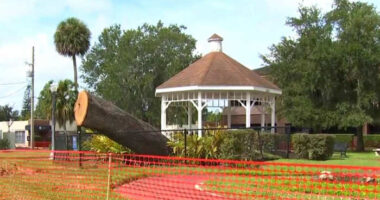Share this @internewscast.com
MISSOURI (KTVI) – What started as a casual trip in Missouri’s spring woodlands turned into a once-in-a-lifetime morel mushroom moment for a lucky family.
Jeremiah Wixson and his son, River, were exploring a rural area in central Missouri on April 30 when they spotted a massive morel mushroom, nearly the size of River’s head, among a cluster of dozens. “I think we hit the mother lode!” River exclaimed at the time.
Jeremiah and River are seasoned morel mushroom hunters, but this particular find stood out as exceptional.
“I have been hunting morels since I was 10, so for 26 years, and have never seen anything like it,” Jeremiah said.
A photo from the day shows River smiling proudly while holding the enormous morel, which appears more than twice the size of his hands and nearly as long as his head. For comparison, most morel mushrooms only grow around 1 to 4 inches tall, according to FarmAndDairy.com.

Jeremiah shared the photo of their discovery in a Morel Mushroom Reports Facebook group, where the post quickly made waves, earning 14,000 likes, 700 shares and nearly 1,000 supportive comments.
“We will probably never see anything like it again, but to get to share that experience with my family is something I’ll never forget,” said Jeremiah.
In total, the father-son duo picked 48 morel mushrooms that day and spotted at least 40 others in the area, which they chose to leave behind.
Morel mushroom hunting is a beloved springtime tradition in Missouri. Though they may look odd with their brain-like appearance and earthy color, morels are scarce in nature and highly prized. And best of all, when cooked properly, they offer a rich, meaty texture, far different than the typically sliminess often associated with other mushrooms.
According to the Missouri Department of Conservation, morels typically appear from late March to early May, thriving in moist conditions with daytime temperatures in the 70s and nighttime temperatures in the 50s.
Early in the season, south- and west-facing slopes are prime for foraging, while north and east slopes become more productive later on. Morels often grow near elms, ashes, cottonwoods and recently dead trees. Sometimes, areas affected by flooding, fires or logging may also yield an abundance of morel mushrooms.
For those foraging on public land, it’s important to check local regulations before collecting mushrooms for personal use. For more information on morel mushrooms and sightings near you, click here.












